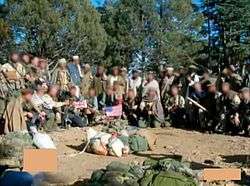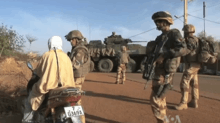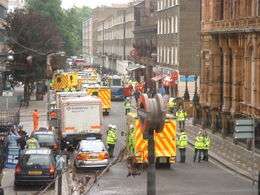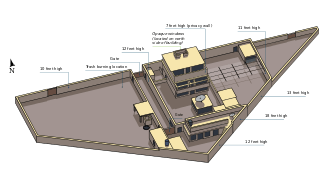Timeline of the War on Terror
The War on Terror is the campaign launched by the United States of America in response to the September 11 attacks against organizations designated with terrorism.[1][2] The campaign, whose stated objective was eliminating international terrorism, began in 2001.[3] The following is a timeline of events linked to the War on Terror.
2001

American and British special forces operators at
Tora Bora, December 2001.
| Dates | Events | |
| September 11 |
The September 11, 2001 attacks in New York City, Washington D.C., and Shanksville, Pennsylvania, United States, killed 2,993 people.[4][5] |
| September 12 |
The United Nations Security Council unanimously adopted Resolution 1368: condeming the September 11 attacks, calling on all countries to co-operate in bringing the perpetrators, organisers and sponsors of the attacks to justice and that those responsible for supporting or harbouring the perpetrators, organisers and sponsors would be held accountable. |
| September 14 |
Operation Noble Eagle begins, the United States and Canadian military launch operations related to homeland security in response to the September 11 attacks[6] |
| September 18 and October 9 |
2001 anthrax attacks kill 5 and infect 17 others by anthrax spores in New York City, New York, Boca Raton, Florida, and Washington D.C. in the United States.[7] |
| September 20 |
The phrase "War on Terror" was first officially used.[8] |
| October 7 |
The War in Afghanistan begins.[9] with the Invasion of Afghanistan, under the codename Operation Enduring Freedom |
| October 9 |
Operation Eagle Assist begins, 13 NATO nations execute operational sorties over the skies of the United States in NATO AWACS aircraft. |
| October 16 |
Operation Active Endeavour officially begins.[10][11][12] |
| October 26 |
Congress pass the Patriot Act this allows search and electronic surveillance powers of federal agencies while investigating persons suspected of terrorism. |
| November 9–10 |
The Fall of Mazar-i-Sharif takes place: U.S. and Northern Alliance forces capture the city of Mazar-i-Sharif in Balkh Province from Taliban, Al-Qaeda, IMU and other foreign fighters, the Northern Alliance suffered 38 killed whilst the terrorists suffered over 300 killed, 500 captured and 1,000 defected. |
| November 11–23 |
The Siege of Kunduz takes place: U.S. and Northern Alliance forces besieged the city of Kunduz Taliban, Al-Qaeda and IMU fighters occupied, coalition forces eventually took the city, killing or wounding 2,000 enemy combatants and capturing 3,500 more, however 5,000 terrorists were airlifted by the Pakistan Air Force to North Pakistan. |
| November 25–December 1 |
The Battle of Qala-i-Jangi takes place: Taliban, Al-Qaeda and IMU prisoners begin an uprising at Qala-i-Jangi fortress against its Northern Alliance guards and CIA interrogators, US, British and Northern Alliance forces eventually quell the uprising, out of a total of 300-500 enemy combatants, 86 were recapturied the rest were killed in the battle. 1 American was killed. |
| December 6–17 |
The Battle of Tora Bora takes place: Coalition forces almost captured/killed Osama Bin Laden in Pachir Aw Agam District, Nangarhar Province but he evaded them and later escaped into Pakistan, however, 200 Al-Qaeda and Taliban fighters were killed |
| December 18 |
Operation Enduring Freedom – Kyrgyzstan begins[13] |
2002
_assigned_to_Combined_Task_Force_One_Five_Zero_(CTF-150)_assemble_in_a_formation_for_a_photo_exercise.jpg)
Multinational warships assigned to
CTF-150 taking part in
OEF–HOA, assemble in a formation.
2003
2004
| Dates | Events | |
| March 11 |
The Madrid train bombings kill 191 and injure over 2,000 people. |
| March 16 |
War in North-West Pakistan begins. |
| April 24 |
The Georgia Train and Equip Program ends |
| May 29 |
The Khobar massacre kills 22 and injures 25 people. |
| June 18 |
The United States government, led by the Central Intelligence Agency's Special Activities Division, begins a series of ongoing attacks on targets in northwest Pakistan using drones (unmanned aerial vehicles). These attacks sought to defeat the Taliban and Al-Qaeda militants who were thought to have found a safe haven in Pakistan.[25] |
| September 9 |
The bombing of the Australian Embassy in Jakarta killed 8 and wounded 150 people. |
| November 7–December 23 |
The Second Battle of Fallujah takes place: US, UK and Iraqi forces launch an offensive to liberate Fallujah from AQI terrorists and Iraqi insurgents, killing 1,200–1,500 enemy combatants, whilst 1,500 more were captured, coalition forces suffered 107 killed and 613 wounded.[26] |
2005
2006
| Dates | Events | |
| June 4 |
Islamist insurgents begin taking over large parts of Somalia. |
| June 7 |
2 U.S. F-16C Jets carryout an airstrike on a farmhouse/safehouse in Hibhib a village outside Baquba killing AQI's leader Abu Musab al-Zarqawi.[30] |
| June 17–November 15 |
The Second Battle of Ramadi takes place: U.S. and Iraqi forces mostly drive AQI (from mid-October it was reformed as ISI) and other Sunni insurgents out of their de facto capital:Ramadi, 750 militants were killed, the US lost 80+ killed and 200+ wounded whilst the Iraq lost 30 troops and policemen killed |
| July 20 |
The War in Somalia (2006–09) begins when U.S. backed Ethiopian troops invaded Somalia to support the Somali Transitional Government against Islamist insurgents |
| August 17 |
The Second Battle of Habbaniyah begins: In the urban sprawl between Fallujah and Ramadi. One of the most vicious and protracted battles of the war causes the deaths of some 14 Marines and 37 insurgents. resulting in a Coalition victory, causing the flow of supplies and terrorists into the major cities to dry up permanently. |
| November 5 |
Saddam Hussein is sentenced to death by hanging, he is hanged on December 30 at Camp Justice in Baghdad. |
2007
2008
| Dates | Events | |
| Unknown |
Operation Enduring Freedom – Caribbean and Central America begins[34] |
| April 6 |
The Battle of Shok Valley takes place: U.S. Aircraft supporting U.S. Special forces, as well as Afghan special forces raided a fortified town in Shok Valley of Nuristan Province, occupied by HIG in an attempt to eliminate Gulbuddin Hekmatyar. The raid failed to eliminate him, U.S. forces suffered multiple wounded, ANA suffered 2 killed and multiple wounded. |
| June 2 |
The Danish embassy bombing in Islamabad killed between 6-8 people and injured over 20. |
| July 13 |
The Battle of Wanat took place: between 200-500 militants from the Taliban, al-Qaeda and HIG attacked an outpost in Nuristan province garrisoned by US and Afghan troops, the attack was repulsed, 9 US soldiers and 15 more wounded, 4 Afghan soldiers were wounded and at least 40 Taliban fighters killed during the assault.[35] |
| August 7 |
The Battle of Bajaur begins: Pakistani forces launch an offensive to retake, Bajaur in Khyber-Pakhtunkhwa Province from TTP, Al-Qaeda and TNSM |
| September 11 |
The Cyberwarfare section of JSOC shut down every jihadist Website that was known to them.[36] |
| October 26 |
The Abu Kamal raid takes place: U.S. SOF cross into Syria via helicopter and eliminated Abu Ghadiya who was primarily involved in al-Qaeda's logistic effort in Iraq and assisted in smuggling weapons, money and fighters across the Syria-Iraq border and several other militants. |
| November 26–29 |
The Mumbai attacks kill 156-164 and injure 293-600+ people |
2009
| Dates | Events | |
| January 30 |
The War in Somalia (2006–09) ends after Ethiopian forces withdraw from Somalia. |
| January/February |
The War in Somalia (2009–present) begins. |
| February 28 |
The Battle of Bajaur ends: Pakistani forces killing 1,500 terrorists and wounding 2,000 more, whilst the Pakistanis lost 97 killed, 404 wounded and 5 captured, 176+ tribesmen were also killed. |
| April 16 |
The Insurgency in the North Caucasus begins. |
| April 26–June 14 |
Operation Black Thunderstorm takes place: The Pakistani military captures a number of districts in Khyber-Pakhtunkhwa Province from TTP and TNSM, killing 1,475 terrorists and capturing 114 more, whilst the Pakistani's lost over 150 killed, 95 captured (18 rescued) and 317 wounded. |
| May 16–July 15 |
As part of the third phase of Operation Black Thunderstorm, the Second Battle of Swat takes place: Pakistani forces fought for control of Swat Valley against TTP, TNSM and LeI terrorists, eventually returning it to government control, killing 2,088 terrorists whilst the Pakistanis lost 168 killed, 454 wounded. |
| June 19–December 12 |
Operation Rah-e-Nijat takes place: The aim of the operation by the Pakistani military was to regain control of South Waziristan from the TTP, IMU, Jama'at al-Jihad al-Islami/IJU (an IMU splinter faction), al-Qaeda and other foreign jihadists terrorists, the operation was a success, ground forces killed 619 terrorists and caotured 83 more, whilst losing approximately 200 killed and 600 wounded. |
| July 26 |
The Boko Haram insurgency begins. |
| August 6 |
Newly elected Obama administration has stopped using the phrase "war on terror";[37] John Brennan announces that the U.S. is "at war with al Qaeda", not involved in a "global war on terror"[38] |
| September 1-November 30 |
The Khyber Pass offensive takes place: Pakistani forces launch an offensive to clear the LeI terrorists in and near the Khyber Pass in Khyber-Pakhtunkhwa Province |
| November 5 |
The Fort Hood shooting kills 13 and injures 33. |
2011
2012
| Dates | Events | |
| January 16 |
The Northern Mali conflict begins when Islamic insurgents (affiliated with Al Qaeda) and a nationalist rebel group launch an offensive against the Mali government. |
| March 8 |
The Sokoto hostage rescue attempt takes place: Operators from the SBS and Nigerian army soldiers attempted to rescue a British and Italian hostage in Sokoto, Nigeria who were being held by members of Boko Haram who were backed by Al Qaeda, calling themselves "al-Qaida in the land beyond the Sahil". The rescue mission failed, both hostages were murdered by their captors, however 8 of them were killed and 2-3 arrested. |
| September 11 |
The Benghazi attack by Islamist militants kills 4 and injures 7 |
2013

French soldiers on patrol in
Gao, spring 2013.
| Dates | Events | |
| January 11 |
The Bulo Marer hostage rescue attempt takes place: Operators from the DGSE attempted to rescue 2 French hostages Bulo Marer, Somalia being held by Al-Shabaab, the rescue mission failed, 2 DGSE operators were killed as was the hostage, 17 Al-Shabaab terrorists were killed. |
| January 13 |
The French Military, supported by several African nations intervene in the Northern Mali Conflict, supporting Mali security forces against MOJWA, AQIM and Ansar Dine |
| January 16 |
The In Amenas hostage crisis in Algeria begins, ending on January 19, which kills 40 hostages. |
| May 11 |
The Reyhanlı bombings in Turkey kill 52 and injure 140. |
| September 21 to 24 |
The Westgate shopping mall attack in Nairobi, Kenya kills 67 and injures 175. |
2014

Two U.S. F-15E's flying over Iraq after conducting airstrikes in Syria, 23 September 2014.
| Dates | Events | |
| June 3 |
Operation Enduring Freedom – Kyrgyzstan ends. |
| June 13 |
International campaign against ISIL begins with the American-led intervention in Iraq against Islamic State of Iraq and the Levant. |
| June 15 |
The Pakistani military began Operation Zarb-e-Azb: A military offensive to "flush out" all foreign and local militants hiding in North Waziristan, including the TTP, IMU, ETIM, LeJ, al-Qaeda, Jundallah and the Haqqani network. |
| July 4 |
Operators from Delta force attempted to rescue two dozen hostages who was being held by ISIS in Syria, but it was discovered that the hostages had been moved 24 hours before, at least 5 ISIS militants were killed during the mission. |
| July 15 |
Operation Serval: the French and African intervention in the Northern Mali conflict ends, the operation killed Between 600–1,000 terrorists and captured 109–300 more. |
| August 1 |
Operation Barkhane began: French and African forces began anti-insurgent operation in Africa's Sahel region, particularly against Al-Mourabitoun, AQIM, Ansar Dine. |
| September 22 |
The international campaign against ISIS continues with the American-led intervention in Syria |
| November 26–December 6 |
U.S. Navy SEALs and soldiers from the Yemeni Army carried out missions to rescue hostages being held by AQAP in Yemen: On the first raid– 8 hostages were rescued and 7 AQAP terrorists were killed. On the second raid: a firefight ensued 6 AQAP terrorists were killed, 2 hostages were mortally wounded and later died. |
| December 16 |
The Peshawar school massacre in Pakistan killed 149 and injured 114 people. |
| December 28 |
NATO officially ended combat operations in Afghanistan[40] ending the War in Afghanistan (2001–2014) |
2015
2016
| Dates | Events | |
| January 14 |
The 2016 Jakarta attacks kills 2 and injures 24. |
| March 22 |
The 2016 Brussels bombings kills 31 and injures 300. |
| April 3 |
The main phase of Operation Zarb-e-Azb ends, clearing 98% of North Waziristan by December 2015, killing 3,500 terrorists and arresting over 1,000, whilst Pakistani forces suffered 587 killed and 2,194 injured. |
| July 14 |
The 2016 Nice attack kills 84+ and injures 202. |
| July 15 |
US' intelligence agencies and congress released declassified "The 28 Pages" from the inquiry commission report, revealing that some of the September 11 hijackers received financial support from individuals connected to the Saudi Government. |
| July 18 |
The leader of MIT/EIM – an Islamic terrorist group that pledged allegiance to ISIS – Abu Wardah Santoso and another MIT terrorist was killed in a firefight with Indonesian security forces in a jungle near Poso[42][43] |
| August 1 |
The U.S. military, with support of other nations forces, began Operation Odyssey Lightning: A sustained campaign against ISIS in Libya, particularly around Sirte in support of the UN-backed Libyan government. |
Notes
- ↑ Combs, Cindy C.; Slann, Martin (2007). Encyclopedia of Terrorism. New York NY: Infobase Publishing. pp. 417–424. ISBN 0-8160-6277-3.
- ↑ "Homeland Security: War on Terror Timeline" (PDF). Retrieved April 3, 2010.
- ↑ "Presidential Address to the Nation" (Press release). The White House. October 7, 2001.
- ↑ "War Casualties Pass 9/11 Death Toll". CBS News. September 22, 2006. Retrieved September 24, 2008.
- ↑ Brzezinski, Zbigniew (March 25, 2007). "Terrorized by 'War on Terror'". The Washington Post. Retrieved April 3, 2010.
- ↑ "Operations Noble Eagle, Enduring Freedom, and Iraqi Freedom: Questions and Answers About U.S. Military Personnel, Compensation, and Force Structure" (PDF). Congressional Research Service, Library of Congress. Retrieved 21 December 2009. .
- ↑ Lines, Andy; Rock, Lucy (October 13, 2001). "War On Terror: ANTHRAX ATTACK IN NEW YORK; NBC woman tests positive amid germ blitz fear.". The Free Library. The Mirror. Retrieved April 3, 2010.
- ↑ "Transcript of President Bush's address". CNN. 20 September 2001.
- ↑ Bowman, Karlyn (July 24, 2008). "America and the War on Terror" (PDF). American Enterprise Institute for Public Policy Research. Retrieved April 3, 2010.
- ↑ "NATO welcomes Russian offer to contribute to expanded anti-terror patrols in Mediterranean". Istanbul, Turkey: AP Worldstream. June 28, 2004. Retrieved April 3, 2010.
- ↑ Whitmore, Brian (March 28, 2004). "NATO faces challenges as it retools for the war on terror". The Boston Globe. Mons, Belgium. Retrieved April 3, 2010.
- ↑ Josar, David (September 27, 2003). "Jones: EUCOM war role could increase". Stuttgart, Germany: Stars and Stripes. Retrieved April 3, 2010.
- ↑ Daniel P. Bolger, Why we lost: A general's inside account of the Iraq and Afghanistan wars, 2014, xiii
- ↑ "SAS joins Kashmir hunt for bin Laden". Telegraph.co.uk. 23 February 2002. Retrieved 14 September 2014.
- ↑ Brookes, Peter. "Flashpoint: No bungle in the jungle". Armed Fources Journal. Retrieved April 3, 2010.
- ↑ "Why side with Sakaashvili?". Oxford Analytica. November 22, 2008. Retrieved April 4, 2010.
- ↑ Benjamin, Daniel (April 2005). "2". America and the World in the Age of Terror (1 ed.). Center for Strategic & International Studies. pp. 37–46. ISBN 0-89206-452-8. Retrieved April 4, 2010.
- ↑ Wheeler, Kurtis; Stillings, Kris (2006). "In the Republic of Georgia: Cooperative engagement in the war on terror". Marine Corps Gazette. Retrieved April 3, 2010.
- ↑ "Intelligence Center offers MTTs on cultural awareness, intel topics". Infantry Magazine. May–June 2008. Retrieved April 3, 2010.
- ↑ Walter Pincus (November 26, 2002). "U.S. Says Yemen Aided Missile Strike". The Daily Gazette. Retrieved May 20, 2010.
- ↑ Callinicos, Alex (March 19, 2005). "Anti-war protests do make a difference". Socialist Worker (1943). Retrieved April 3, 2010.
- ↑ Bush, George W. (September 9, 2003). "A Central Front in the War on Terror, From the President's speech to the Nation". Retrieved April 3, 2010.
- ↑ Bush, George W. (August 21, 2006). "Press Conference by the President; White House Conference Center Briefing Room". Washington DC, United States. Retrieved April 3, 2010.
- ↑ "Saddam Captured 'Like a Rat' in Raid – Fox News". Fox News. October 21, 2011.
- ↑ The CIA's Silent War in Pakistan, TIME, June 1, 2009
- ↑ "Iraq's hardest fight: The US battle for Falluja 2004". BBC. 10 November 2014.
- ↑ Cole, Juan (July 8, 2005). "The time of revenge has come". Salon. Retrieved April 3, 2010.
- ↑ Croft, Stuart (October 2, 2006). Culture, Crisis and America's War on Terror. New York, NY: Cambridge University Press. pp. 232–234. ISBN 0-521-68733-0. Retrieved April 4, 2010.
- ↑ Wade, Marianne; Maljevic, Almir (November 18, 2009). A War on Terror? (1 ed.). New York, NY: Springer. p. 336. ISBN 0-387-89290-7. Retrieved April 4, 2010.
- ↑ Urban, Mark, Task Force Black: The Explosive True Story of the Secret Special Forces War in Iraq , St. Martin's Griffin , 2012 ISBN 1250006961 ISBN 978-1250006967,p.148-149,p.159-160
- ↑ "The Battle of Ras Kamboni". long war journal. 8 January 2007.
- ↑ Urban, Mark, Task Force Black: The Explosive True Story of the Secret Special Forces War in Iraq , St. Martin's Griffin , 2012 ISBN 1250006961 ISBN 978-1250006967,p.209-210
- ↑ "Operation Enduring Freedom – Trans Sahara (OEF-TS". GlobalSecurity.org. Retrieved February 6, 2007.
- ↑ "Operation Enduring Freedom - Caribbean, Central America (OEF-CCA)". Retrieved 19 February 2015.
- ↑ "Joint al Qaeda and Taliban force behind Nuristan base attack". long war journal. 14 July 2008.
- ↑ "'Top Secret America': A look at the military's Joint Special Operations Command". Washington post. 2 September 2011.
- ↑ Foon Rhee, "Cheney blasts Obama on Christmas Day plane scare", Boston Globe, 30 December 2009.
- ↑ Toby Harnden, "Barack Obama adviser rejects 'global war on terror'", Telegraph, 7 August 2009.
- ↑ "Osama Bin Laden Death Prompts Networks to Break Into Programming". The Hollywood Reporter. May 1, 2011.
- ↑ "U.S. formally ends the war in Afghanistan". CBA News. 28 December 2014.
- ↑ "'Probably the largest' al-Qaeda training camp ever destroyed in Afghanistan". the Washington post. October 30, 2015.
- ↑ "Indonesia most-wanted terrorist killed in a gunfight with police". CNN. 20 July 2016.
- ↑ "Police Say They Have Killed Indonesia's Most-Wanted Terrorist". Time. 19 July 2016.
References
|
|---|
|
|
|
| Participants | |
|---|
|
| Conflicts | |
|---|
|
| See also | |
|---|
|
-
 Terrorism portal Terrorism portal
-
 War portal War portal
|









_assigned_to_Combined_Task_Force_One_Five_Zero_(CTF-150)_assemble_in_a_formation_for_a_photo_exercise.jpg)